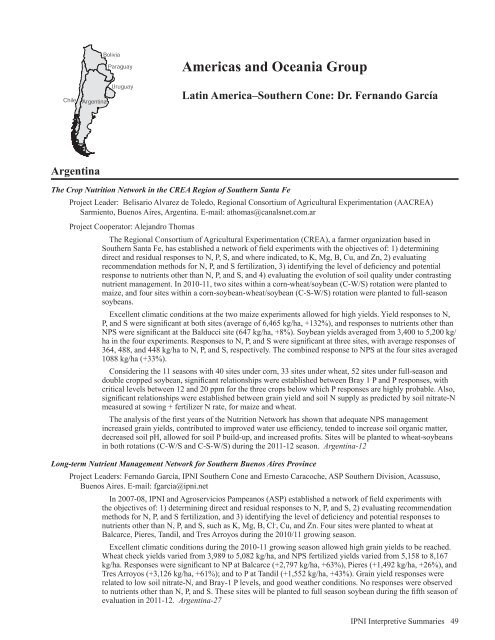Americas and Oceania Group - International Plant Nutrition Institute
Americas and Oceania Group - International Plant Nutrition Institute
Americas and Oceania Group - International Plant Nutrition Institute
You also want an ePaper? Increase the reach of your titles
YUMPU automatically turns print PDFs into web optimized ePapers that Google loves.
Chile<br />
Bolivia<br />
Paraguay<br />
Uruguay<br />
Argentina<br />
<strong>Americas</strong> <strong>and</strong> <strong>Oceania</strong> <strong>Group</strong><br />
Latin America–Southern Cone: Dr. Fern<strong>and</strong>o García<br />
Argentina<br />
The Crop <strong>Nutrition</strong> Network in the CREA Region of Southern Santa Fe<br />
Project Leader: Belisario Alvarez de Toledo, Regional Consortium of Agricultural Experimentation (AACREA)<br />
Sarmiento, Buenos Aires, Argentina. E-mail: athomas@canalsnet.com.ar<br />
Project Cooperator: Alej<strong>and</strong>ro Thomas<br />
The Regional Consortium of Agricultural Experimentation (CREA), a farmer organization based in<br />
Southern Santa Fe, has established a network of field experiments with the objectives of: 1) determining<br />
direct <strong>and</strong> residual responses to N, P, S, <strong>and</strong> where indicated, to K, Mg, B, Cu, <strong>and</strong> Zn, 2) evaluating<br />
recommendation methods for N, P, <strong>and</strong> S fertilization, 3) identifying the level of deficiency <strong>and</strong> potential<br />
response to nutrients other than N, P, <strong>and</strong> S, <strong>and</strong> 4) evaluating the evolution of soil quality under contrasting<br />
nutrient management. In 2010-11, two sites within a corn-wheat/soybean (C-W/S) rotation were planted to<br />
maize, <strong>and</strong> four sites within a corn-soybean-wheat/soybean (C-S-W/S) rotation were planted to full-season<br />
soybeans.<br />
Excellent climatic conditions at the two maize experiments allowed for high yields. Yield responses to N,<br />
P, <strong>and</strong> S were significant at both sites (average of 6,465 kg/ha, +132%), <strong>and</strong> responses to nutrients other than<br />
NPS were significant at the Balducci site (647 kg/ha, +8%). Soybean yields averaged from 3,400 to 5,200 kg/<br />
ha in the four experiments. Responses to N, P, <strong>and</strong> S were significant at three sites, with average responses of<br />
364, 488, <strong>and</strong> 448 kg/ha to N, P, <strong>and</strong> S, respectively. The combined response to NPS at the four sites averaged<br />
1088 kg/ha (+33%).<br />
Considering the 11 seasons with 40 sites under corn, 33 sites under wheat, 52 sites under full-season <strong>and</strong><br />
double cropped soybean, significant relationships were established between Bray 1 P <strong>and</strong> P responses, with<br />
critical levels between 12 <strong>and</strong> 20 ppm for the three crops below which P responses are highly probable. Also,<br />
significant relationships were established between grain yield <strong>and</strong> soil N supply as predicted by soil nitrate-N<br />
measured at sowing + fertilizer N rate, for maize <strong>and</strong> wheat.<br />
The analysis of the first years of the <strong>Nutrition</strong> Network has shown that adequate NPS management<br />
increased grain yields, contributed to improved water use efficiency, tended to increase soil organic matter,<br />
decreased soil pH, allowed for soil P build-up, <strong>and</strong> increased profits. Sites will be planted to wheat-soybeans<br />
in both rotations (C-W/S <strong>and</strong> C-S-W/S) during the 2011-12 season. Argentina-12<br />
Long-term Nutrient Management Network for Southern Buenos Aires Province<br />
Project Leaders: Fern<strong>and</strong>o García, IPNI Southern Cone <strong>and</strong> Ernesto Caracoche, ASP Southern Division, Acassuso,<br />
Buenos Aires. E-mail: fgarcia@ipni.net<br />
In 2007-08, IPNI <strong>and</strong> Agroservicios Pampeanos (ASP) established a network of field experiments with<br />
the objectives of: 1) determining direct <strong>and</strong> residual responses to N, P, <strong>and</strong> S, 2) evaluating recommendation<br />
methods for N, P, <strong>and</strong> S fertilization, <strong>and</strong> 3) identifying the level of deficiency <strong>and</strong> potential responses to<br />
nutrients other than N, P, <strong>and</strong> S, such as K, Mg, B, Cl - , Cu, <strong>and</strong> Zn. Four sites were planted to wheat at<br />
Balcarce, Pieres, T<strong>and</strong>il, <strong>and</strong> Tres Arroyos during the 2010/11 growing season.<br />
Excellent climatic conditions during the 2010-11 growing season allowed high grain yields to be reached.<br />
Wheat check yields varied from 3,989 to 5,082 kg/ha, <strong>and</strong> NPS fertilized yields varied from 5,158 to 8,167<br />
kg/ha. Responses were significant to NP at Balcarce (+2,797 kg/ha, +63%), Pieres (+1,492 kg/ha, +26%), <strong>and</strong><br />
Tres Arroyos (+3,126 kg/ha, +61%); <strong>and</strong> to P at T<strong>and</strong>il (+1,552 kg/ha, +43%). Grain yield responses were<br />
related to low soil nitrate-N, <strong>and</strong> Bray-1 P levels, <strong>and</strong> good weather conditions. No responses were observed<br />
to nutrients other than N, P, <strong>and</strong> S. These sites will be planted to full season soybean during the fifth season of<br />
evaluation in 2011-12. Argentina-27<br />
IPNI Interpretive Summaries 49

















